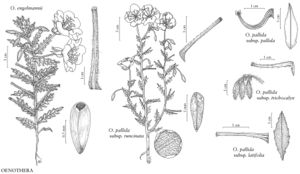Difference between revisions of "Oenothera engelmannii"
Amer. J. Bot. 18: 316. 1931. (as engelmanni)
imported>Volume Importer |
imported>Volume Importer |
||
| Line 57: | Line 57: | ||
|publication year=1931 | |publication year=1931 | ||
|special status= | |special status= | ||
| − | |source xml=https://xjsachs2@bitbucket.org/aafc-mbb/fna-data-curation.git/src/ | + | |source xml=https://xjsachs2@bitbucket.org/aafc-mbb/fna-data-curation.git/src/e39f0e846f172941159b2045254d62d10d9823f6/coarse_grained_fna_xml/V10/V10_118.xml |
|subfamily=Onagraceae subfam. Onagroideae | |subfamily=Onagraceae subfam. Onagroideae | ||
|tribe=Onagraceae tribe Onagreae | |tribe=Onagraceae tribe Onagreae | ||
Latest revision as of 10:31, 9 May 2022
Herbs winter-annual, conspicuously villous throughout, also strigillose on leaves and distal parts; from a taproot. Stems erect, unbranched or with few, spreading branches, 30–50(–80) cm. Leaves in a basal rosette and cauline, rosette weakly developed or absent, at least during flowering, (1–)2–6(–8) × 1–2(–3) cm; sessile; blade lanceolate to oblong lanceolate, proximal ones sometimes oblanceolate, margins coarsely repand-dentate or -pinnatifid. Flowers 1–several opening per day near sunset; buds nodding, weakly quadrangular, without free tips; floral tube 20–30 mm; sepals 13–21 mm, not spotted or with scattered small, maroon spots; petals white, fading pink, broadly obovate or obcordate, 15–30 mm; filaments 14–16 mm, anthers 6–8 mm; style 40–50 mm, stigma exserted beyond anthers at anthesis. Capsules widely spreading, woody in age, straight or slightly curved, cylindrical, obtusely 4-angled, especially toward base, tapering gradually from base to apex, 30–60 × 2–3 mm; sessile. Seeds numerous, in 1 row per locule, brown, narrowly obovoid, 1–1.5 mm. 2n = 14.
Phenology: Flowering Apr–Aug(–Sep).
Habitat: Sandy prairies, dunes, disturbed areas, roadsides.
Elevation: 500–1300 m.
Distribution
Colo., Kans., N.Mex., Okla., Tex.
Discussion
Oenothera engelmannii is self-incompatible (W. L. Wagner et al. 2007; K. E. Theiss et al. 2010). It has a relatively narrow distribution in sandy areas of eastern New Mexico and western Texas, extending to southeastern Colorado, western Oklahoma, and southwestern Kansas. The flower size seems to vary, with larger flowers in eastern New Mexico and considerably smaller flowers in the eastern part of its range.
Selected References
None.
